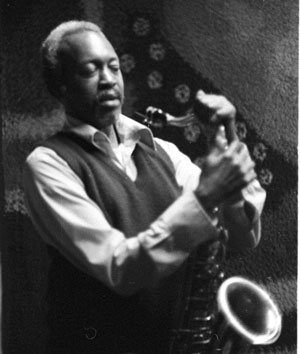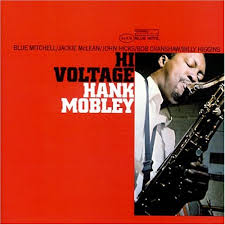Flirty Gerty – Hank Mobley
A funky medium groove song in a distinctive '60s style. A full score and parts are available for the sextet arrangement on the recording.
- Recording: Hank Mobley - Hi Voltage
- Recorded on: October 9, 1967
- Label: Blue Note (BLP 4273)
- Concert Key: B-flat
- Vocal Range: , C4 to C4
- Style: Swing (medium)
- Trumpet - Blue Mitchell
- Alto Sax - Jackie McLean
- Tenor Sax - Hank Mobley
- Piano - John Hicks
- Bass - Bob Cranshaw
- Drums - Billy Higgins
0:00
0:00
Buy MP3
Purchase Flirty Gerty - Hank Mobley
Purchasing this song through our affiliate links with certain retailers provides jazzleadsheets.com with additional support to help keep us bringing you the best lead sheets available. Thank you!
Video
- Description
- Historical Notes
- Solos
- Piano Corner
- Bass Corner
- Drum Corner
- Guitar Corner
- Inside & Beyond
- Minus You
Flirty Gerty is a classic example of '60s Blue Note soul-jazz. It's driven by a funky two-measure rhythm section figure that implies a loping 2-feel. The melody is based on a minor pentatonic scale nearly throughout. In the A section the melody consists of brief, powerful "shout" phrases; the bridge is rather similar to the bridge of Bobby Timmons' Moanin', though without that song's blues scale embellishments.
The rhythm section never goes to a steady 2- or 4-feel; instead, two measures of figures are alternated with two measures where the rhythm section plays freely, a sort of "broken time" but rhythmically related to the preceding figures. The bridge has a similar texture; the figures in measures 1, 2, 5, and 6 are close to a 2-feel but with several chords anticipated by an eighth note. The same rhythm section textures are used in the solos, except with a few more anticipations in the bridge. Click on the Inside & Beyond tab for more details on the rhythm section parts.
The rhythm section vamps the first two measures four times as an intro. The ending vamps and fades on the same rhythm section figures.
In the three-horn arrangement on the recording, the horns play the A section in octaves (trumpet above, alto sax and tenor sax in unison below). The trumpet has the bridge melody, with alto and tenor half notes accompanying. The 3rd and 7th measures of the bridge have the horns voiced in a B♭ minor triad, but the rhythm section plays B♭7 in these measures in the solos.
The rhythm section never goes to a steady 2- or 4-feel; instead, two measures of figures are alternated with two measures where the rhythm section plays freely, a sort of "broken time" but rhythmically related to the preceding figures. The bridge has a similar texture; the figures in measures 1, 2, 5, and 6 are close to a 2-feel but with several chords anticipated by an eighth note. The same rhythm section textures are used in the solos, except with a few more anticipations in the bridge. Click on the Inside & Beyond tab for more details on the rhythm section parts.
The rhythm section vamps the first two measures four times as an intro. The ending vamps and fades on the same rhythm section figures.
In the three-horn arrangement on the recording, the horns play the A section in octaves (trumpet above, alto sax and tenor sax in unison below). The trumpet has the bridge melody, with alto and tenor half notes accompanying. The 3rd and 7th measures of the bridge have the horns voiced in a B♭ minor triad, but the rhythm section plays B♭7 in these measures in the solos.
"Hi Voltage" was recorded at the legendary Van Gelder Studio in Englewood Cliffs.
Click on the album title to check out the other titles on Hank's "Hi Voltage" session. It's one of a few Hank Mobley sessions consisting entirely of his original compositions; another is the February 5, 1965, session mostly issued on "The Turnaround" with two songs on "Straight No Filter." Jackie McLean had recorded as a sideman with Hank once before, on one song from his 1956 Prestige album "Hank Mobley's Message".
Click on the album title to check out the other titles on Hank's "Hi Voltage" session. It's one of a few Hank Mobley sessions consisting entirely of his original compositions; another is the February 5, 1965, session mostly issued on "The Turnaround" with two songs on "Straight No Filter." Jackie McLean had recorded as a sideman with Hank once before, on one song from his 1956 Prestige album "Hank Mobley's Message".
Our detailed piano, bass, and drum parts show how the rhythm section plays on the recording.
Piano: full voicings are shown condensed on one staff. These are a two-handed variation of the classic 4-part dominant 13th voicing (from the bottom up: 7th, 3rd, 13th, and root) used in a lot of '60s soul-jazz. The piano plays solo fills in the "broken time" sections of the head, which are indicated in the part. John Hicks' fills in the bridge are notated, with the word "freely;" pianists can use these as inspiration for their own fills.
Bass: Bob Cranshaw's bass part is mostly notated for the head. The "broken time" sections are written (except the end of the bridge), with the words "freely interpret" added.
Drums: Billy Higgins' pattern is notated for the intro and hits on the A and C sections. His fills—an offbeat triplet pattern both times—are also shown in the "broken time" sections of the bridge. In the "broken time" on the A sections, he plays similarly to the pattern in the first two measures—only slightly differently with a few fills; the "broken time" mostly comes from the bass.
Piano: full voicings are shown condensed on one staff. These are a two-handed variation of the classic 4-part dominant 13th voicing (from the bottom up: 7th, 3rd, 13th, and root) used in a lot of '60s soul-jazz. The piano plays solo fills in the "broken time" sections of the head, which are indicated in the part. John Hicks' fills in the bridge are notated, with the word "freely;" pianists can use these as inspiration for their own fills.
Bass: Bob Cranshaw's bass part is mostly notated for the head. The "broken time" sections are written (except the end of the bridge), with the words "freely interpret" added.
Drums: Billy Higgins' pattern is notated for the intro and hits on the A and C sections. His fills—an offbeat triplet pattern both times—are also shown in the "broken time" sections of the bridge. In the "broken time" on the A sections, he plays similarly to the pattern in the first two measures—only slightly differently with a few fills; the "broken time" mostly comes from the bass.
Related Songs
Email Send Flirty Gerty to a friend
Send this page to a friend via email. Add your name or email in the first field. In the second, add one or more email addresses, separated by a comma.

Hank Mobley
July 7, 1930 – May 30, 1986
Hank Mobley is one of the most acclaimed tenor saxophonists in modern jazz history. He is recognized by musicians and critics alike as one of the most important and eloquent jazz instrumentalists of all time. He recorded well over 100 of his own original compositions and left an indelible mark on the post-bop jazz scene. Read more...
There was a problem.
...

